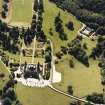Inveraray Castle Estate, Cherry Park, House And Farm Offices
Farmhouse (18th Century) (1760)
Site Name Inveraray Castle Estate, Cherry Park, House And Farm Offices
Classification Farmhouse (18th Century) (1760)
Alternative Name(s) Castle Office; Inveraray Castle Policies
Canmore ID 72941
Site Number NN00NE 30
NGR NN 09316 09227
Datum OSGB36 - NGR
Permalink http://canmore.org.uk/site/72941
- Council Argyll And Bute
- Parish Inveraray
- Former Region Strathclyde
- Former District Argyll And Bute
- Former County Argyll
NN00NE 30.00 NN 09316 09227
NN00NE 30.01 NN 09328 09245 North Range
NN00NE 30.02 NN 09347 09236 East Range
NN00NE 30.03 NN 09332 09213 South Range
NMRS Notes.
Inveraray Castle Estate, Cherry Park.
Architect: Robert Mylne, c.1775.
Joseph Bonomi, 1807 - design for alts - not executed.
Measured Survey (27 June 1988 - 29 June 1988)
RCAHMS surveyed Cherry Park, Court of Offices, Inveraray Castle Estate between 27-29 June 1988 producing a ground floor plan and south elevation at a scale of 1:100. The plan and elevation were redrawn in ink and published at a scale of 1:250 (RCAHMS 1992, 414).
Field Visit (June 1988)
This court of offices, which now houses the Argyll Estate Office and a museum, is situated 230m W of Inveraray Castle (No. 184), to which it is connected by an avenue.
Plans for a coach-house and stables, to replace those associated with the old castle (No. 132), were drawn up by John Adam in 1759 and work began in the following year, but only the E range was roofed in when the 3rd Duke of Argyll died in 1761. The 5th Duke commissioned plans for 'alteration and completion' from William Mylne, and these were carried out in 1772 (en.1*). A plan of 1807 by Joseph Bonomi shows proposed two-storeyed additions against the outer walls of the E and S ranges, as well as identifying the existing uses of the rooms, but these works were not carried out (en.2). Further alterations were made in the 19th century and the1960s, especially in the W and S ranges.
RCAHMS 1992, visited June 1988
[see RCAHMS 1992 No. 191 for a full architectural description]
Publication Account (1990)
Now used as the Argyll Estate Office, this rectangular court was built to house the principal stables and coach-houses serving the new castle (John Adam, architect, 1758-61; completed by William Mylne, 1772-3). The E front, with its arched entry and Venetian windows, was much admired by early visitors. The open external arcade of the range was later infilled. In 1807 Joseph Bonomi prepared a scheme (not adopted) for doubling the width of the S and E ranges with additonal stables and coach-houses equal in height to the corner pavilions. At that period the E range contained the brewhouse and laundry; the N range, poultry houses and a stable; the W range, a 'flower room' and dairy and domestic accomodation, with a large cow-house (now demolished) to the W; and the S range, stables.
Information from ‘RCAHMS Excursion guide 1990: Commissioners' field excursion, Argyll, 7-9 May 1990’.






































